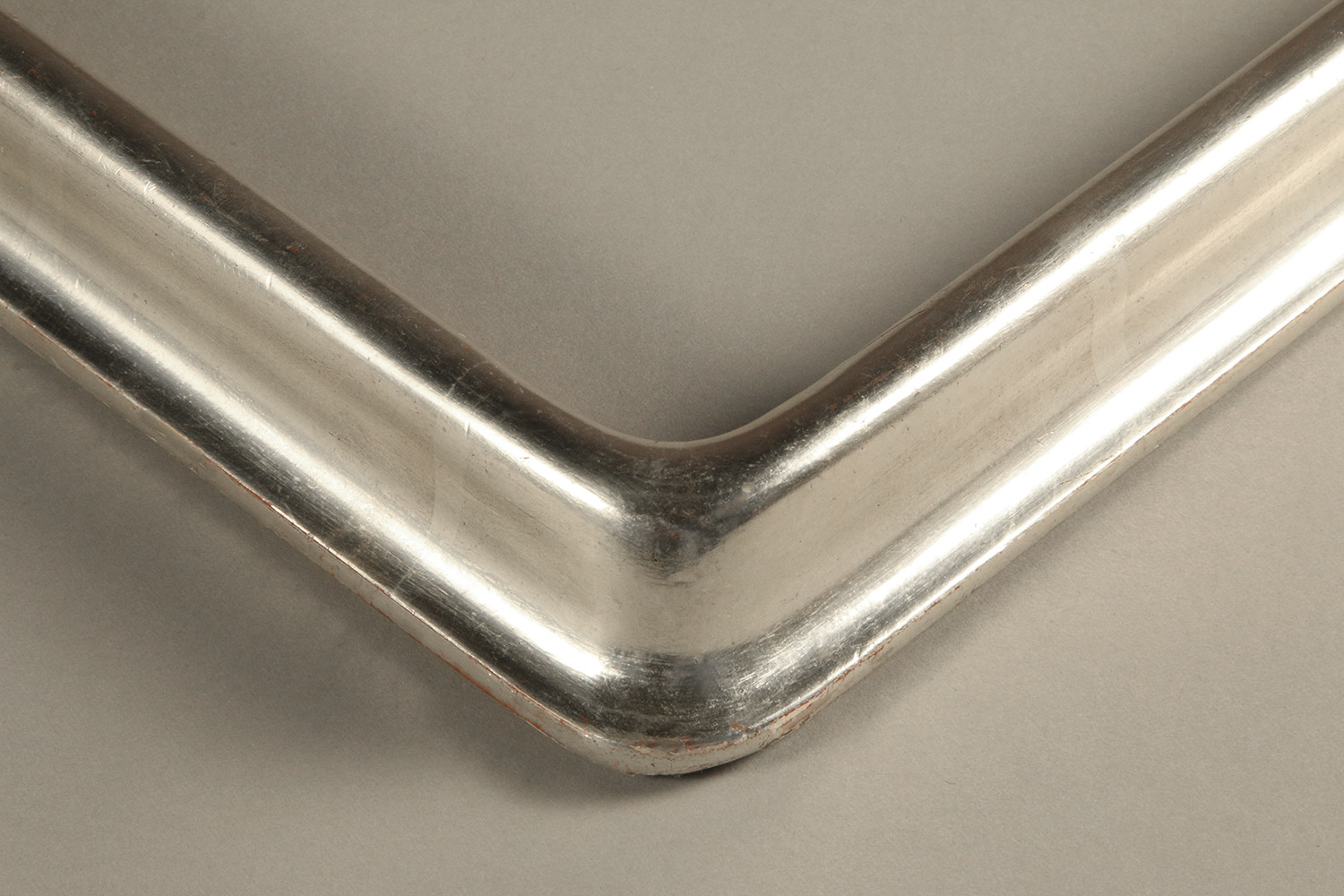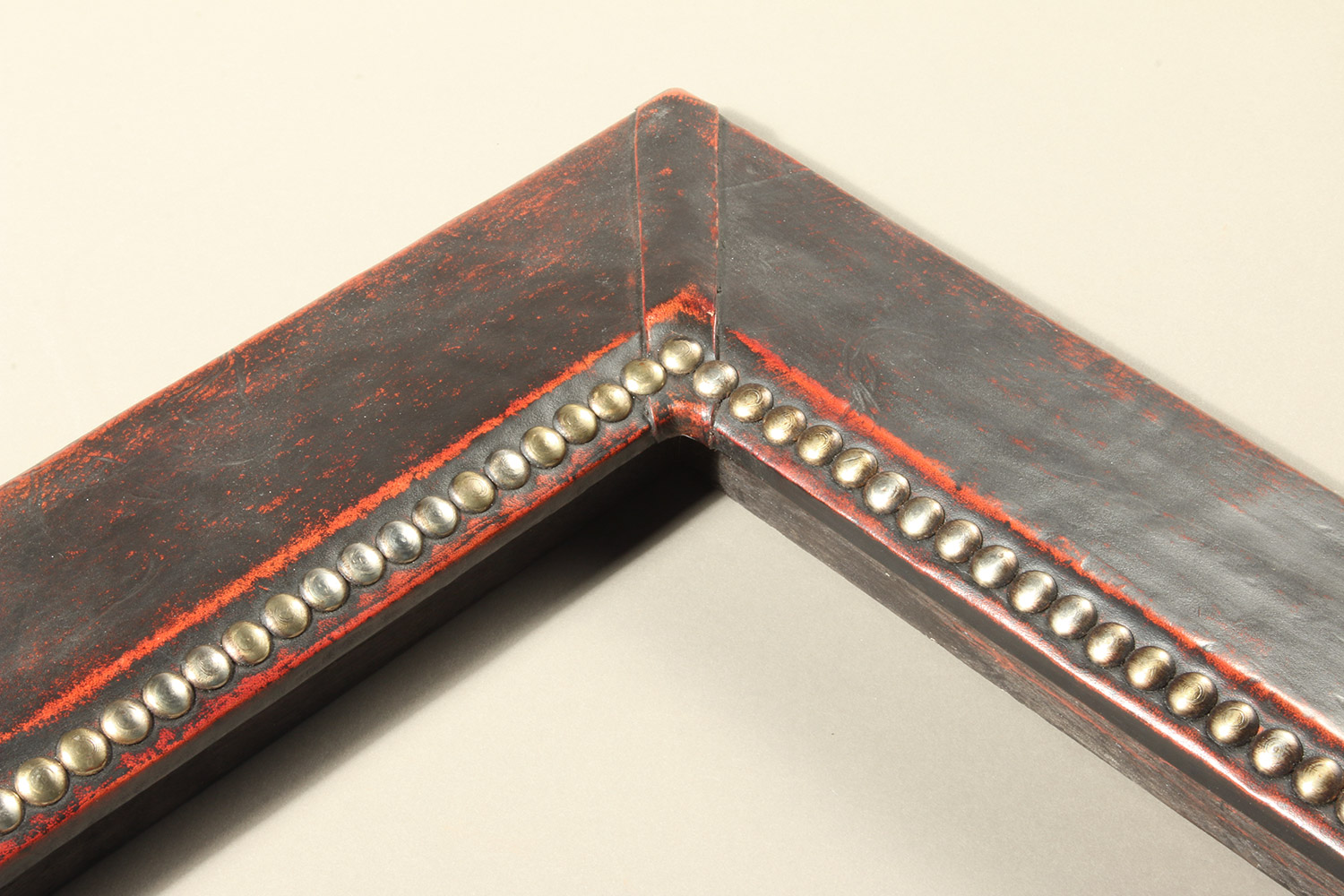Closed Corner Frames:
Seamless by Design
Finished or closed corner frames are the ultimate in quality and craftmanship and are not comparable with cut and joined length mouldings that are available in most frame shops. Closed corner frames are the first choice of museums and galleries. Those frames are completed after their basic lengths are assembled and joined together. The completion involves applying further and more intricate craftsmanship and artistry than just putting 4 prefabricated moldings together around artwork. The finished corner frames have greater potential of quality and value. Once joined, closed corner frames are then finished in a variety of ways from carving, application of cast compo, gesso, gilding, staining, and painting. The options to create a one of a kind frame are endless.
Two similar frames are shown above: cut-to-size length moulding frame and closed corner frame. What is immediately noticeable in the first frame is that the moulding pattern is interrupted at the corner and the decorative details do not fall into an intentional design. There is an obvious detail misalignment where two lengths meet at the 90-degree angle – the evidence of cutting moulded element to exact dimension without consideration for the continued design. The closed corner, on the other hand, features a full, symmetrical layout with carvings on top of the frame face in the corner. The corner strap clearly shows aesthetic difference.
Another example above makes it possible to detect the difference visible in join line present in the corner of the first frame and the lack of the join line on the second profile. The second frame was finished after the rails were joined together. The join profile was infilled and sanded to smooth the surface and then the finish coat was applied further obscuring the joint. This produced smooth result without distracting visibility of the seam.
Example of two finishes on a Florine Stettheimer inspired frame design. The right side is finished with a silver leaf over blue clay and the left side has a 22kt gold leaf over blue clay. With its prominent sculptural design, opaque painted finishes also work well with this profile. Nicknamed the “pie crust frame”, this profile is a bold statement can add elegance to an interior.
Closed corner frames are at the very provenance of framing which originates in the craft of classic furniture making. As in an intricate furniture piece, the joint areas had potential for creative solutions rather than quick fixes. More images below are exemplifying unusual and sophisticated corner and entire design treatments during custom frame fabrication.
Hand carved corner of a decorative trumeau frame design. Note the asymmetric corner and the tactile quality that hand carving provides for the beaded, lamb’s tongue ribbon ornamentation.
The corner in the photo above is transformed into an elaborate carving. The carver will continue rendering the design arrangement of stylized acanthus and scroll work following pencil drawing as well as integrating further detail into the solid wood.
The cassette frame above features continuous guilloche design of intertwined ribbons carved directly in gesso that was applied to the face of the frame after the wooden structure was built. The carving process, sanding, and application of gesso to prepare the surface for bole and water gilding is done in this example the same way as in gilded furniture. Note the attention of the design allowing for the continuity of the design at the corners.
Closed Corner Frame Features
Obscured seams
The join is not visible.
Raking light image of white gilded frame with smooth surface and no visible seam.
No visible seam and the rounded corner in this white gilded frame create a stunning look.
Seamless Continuing Design in the Corner and at Length
The seamlessness is not only the quality of frame corners but also the entire composition. As in the image below, there is a visible design symmetry of the decorative element placement. This unique characteristic is present in highly customized museum quality frames designed and fabricated using the skill of carving, customized moulding, working with gesso, composite materials, bole, and gold leaf.
Detail of a carved reproduction of Barbizon design.
Above: a Louis XV revival frame with ornate central and corner cartouches. Note the intentional wear to reveal the red bole to give the gilded surface warmth.
A Louis XIV revival design with a shallow ornate pattern adorning the rail. Note the intentional placement of decorative corner and central cartouches.
Contemporary carved and incised design on both the face and sides to create a play in the reflected light in the 23kt gold sheen and the shadowed recesses in the profile.
Uniquely Styled Corners
Closed corner frames present endless design possibilities from contemporary carvings, pained panels, and sgraffito designs.
A white gilded frame with a black painted panel with a corner sgraffito design.
Traditional reeded profile with corner straps prepared to host a small 19th century map which is in the process of hinging.
Presenting a client with two closed corner frame samples for prospective framing of historic documents before preparing them for conservation treatment.
A leather wrapped frame adorned with upholstery tacks and leather corner strap makes for a different take in traditional frame finishing.
A charming carved profile with a folk design and painted finish.
This sophisticated custom welded float frame features an elegant thin groove that contrasts with edge thickness and stops at the seamless corner creating the sense of visual relief.
A contemporary decoupaged finish over a joined profile.
Closed corner frames can be as unique and special as the artwork that they house. The fabrication process of the finished corner frames takes more time than working with prefabricated elements, but there is value in waiting. The finished corner frames are a good investment because they are not only superior in quality. They are masterpieces in their own right. These frames are an elegant option for clients who appreciate the exquisiteness of a hand-made original seamless design. Working with a frame designer can add a lot of character to an interior and be a creative collaborative experience as well.
If you have questions, please contact Bernacki & Associates, Inc.
Bernacki & Associates, Inc. specializes in Museum Quality Framing, Fabrication & Display.
Phone: (312) 243-5669
Email: info@bernackiconservation.com

























